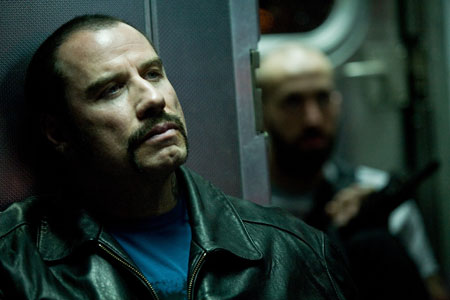The Taking of Pelham 123

The Taking of Pelham 1 2 3, based on the novel by John Godey and related to the 1974 film directed by Joseph Sargent, begins with an establishing shot of New York that looks beautiful for about three seconds, until it is interrupted by a typical Tony Scott opening credits sequence—loud music, fancy title effects swishing back and forth, in and out of frame, intercutting with images of people on the subway. You know how you can tell the kid and his laptop will be relevant? The shot lingers on him for more than a tenth of a second before the next cut.
Cut to a subway rail control station, where Walter Garber (Denzel Washington) is hard at work monitoring the city’s subways. When Garber sees something on his monitors that doesn’t look right, his first reaction isn’t one of puzzlement, but suspicion. This is either bad writing, bad direction, bad acting or a combination of the three. In minutes, a plain-clothed transit police officer gets shot by the gunmen on the train. He is the first of a couple people just dying to be martyred.
John Travolta plays Ryder, the dramatic (read: theatrically bad) villain sporting a Fu Manchu—a modernized Snidely Whiplash. His primary purpose is to act hysterical and googly-eyed throughout most of the film. James Gandolfini plays the wealthy, grandstanding mayor who, it can be surmised, is a loose reference to Michael Bloomberg. There’s even a line about having left his Giuliani suit at home.
Garber makes a connection with Ryder, which Ryder believes he can exploit for sympathy. The two try to psychoanalyze each other. “This is just about money,” says Garber. Ryder replies, “Is it ever about anything else?” We find these types of interactions intriguing dramatically. But in real life, would a criminal so clever as to have orchestrated a controlled abduction of a subway train really want to be talking with Garber? The character’s motivations end up taking a back seat to a cat-and-mouse game in which Garber, with the FBI behind him and a SWAT team at the ready, tries to keep Ryder distracted. It’s all very familiar… but it is kind of fun to see Travolta flip out and issue suggestive non-sequiturs, “He’s got a sexy voice, this man. He’d be my bitch in prison.” You almost begin to wonder if he knows it’s fruitless to take himself seriously in a film such as this.
Everything in this film seems to be on steroids. From the kicky title sequence, to the nauseating title inserts periodically freeze-framing to tell you—BAM—how many minutes remain before Ryder kills his hostages, to the oddly-muscled police cars and motorcycles in the convoy delivering the $10 million ransom. Even the mayor wonders why they didn’t just use a helicopter. But that wouldn’t consume screen time… nor would filming at normal speed—inexplicable slow-motion shots interrupt otherwise technically competent cinematography. Also, I’ve never seen more police cars crash in a single movie than this. NYPD officers are apparently worse drivers than Imperial Stormtroopers are marksmen.
I didn’t get the character depth I wanted to see in the first half—too much cutting before we could read the actors faces. Watch the medium to wide shots in Dog Day Afternoon for an example of effective character development in a hostage situation. Some of the stylistic choices in cinematography, editing, pacing, film speed and depth of field were kind of obtrusive but by the second half of this film it got more interesting. By the time Garber leaves the control station to meet Ryder, they could play it either way. It’s watchable as entertainment, but puzzling why Garber would care enough to follow or shoot Ryder by the time the hostages are rescued. I’m sure most audiences won’t particularly nitpick on that point…
One thing kept bugging me, however. How many more movies are there going to be where the black cop or other authority figure is on the take (think Samuel Jackson in The Negotiator) and his motivation for doing so is to take care of his family. Compare this to when a white cop is on the take in an action film. He’s portrayed as absolutely corrupt. On the surface this seems like it’s more unfair to whites but the subtext is this: Whenever a character is portrayed as a corrupt monster, it’s easier for audiences to dismiss him as a kook—exception to the rule. When a character is potrayed as though being corrupt is just part of looking after his family, it’s as if we’re saying “this is normal for them” and that, to me, is an affront to the intellectual capacity of minorities everywhere.
 The Taking of Pelham 1 2 3 • Dolby® Digital surround sound in select theatres • Aspect Ratio: 2.35:1 • Running Time: 106 minutes • MPAA Rating: R for violence and pervasive language. • Distributed by Columbia Pictures
The Taking of Pelham 1 2 3 • Dolby® Digital surround sound in select theatres • Aspect Ratio: 2.35:1 • Running Time: 106 minutes • MPAA Rating: R for violence and pervasive language. • Distributed by Columbia Pictures